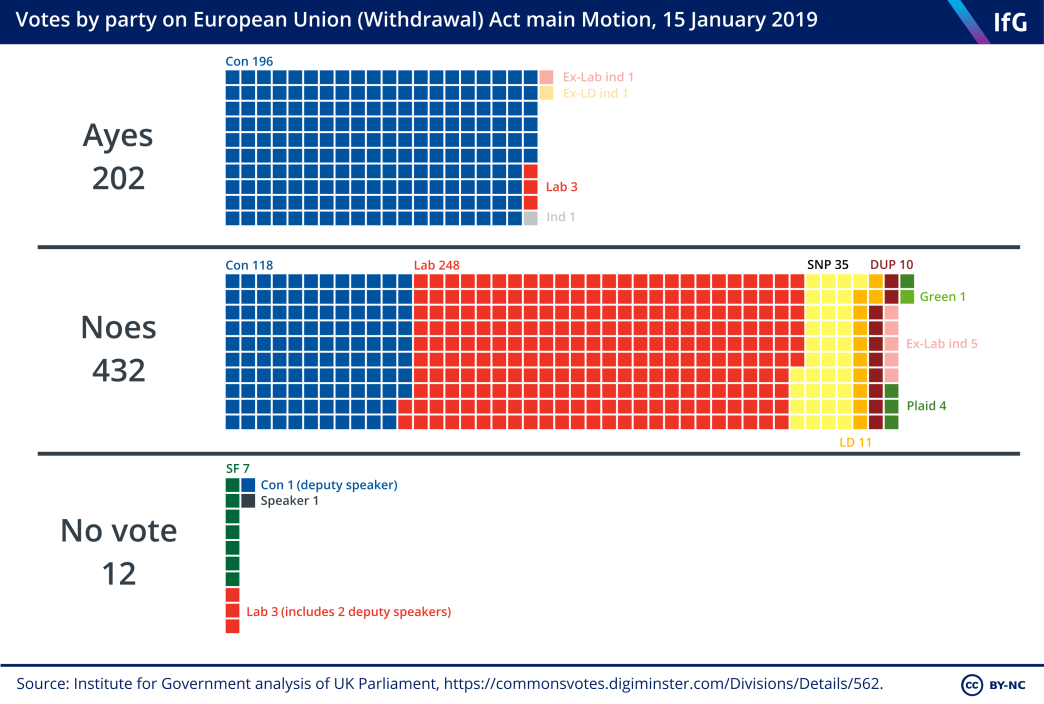The Prime Minister will find it hard to build a cross-party consensus on Brexit
There is no easy consensus around a deal with the EU.
The scale of the Prime Minister’s defeat means she has been forced to look beyond tweaking the backstop to build support for a deal with the EU. But there is no easy consensus there for the taking, argues Jill Rutter.
The Prime Minister lost her deal by a staggering 230 votes. If she is going to win a meaningful vote then at least 115 MPs have to vote the other way, assuming she can hang on to every vote in her lobby this time round. That is an Everest-size mountain to climb.

As MPs were voting last night, the No lobby was united in dislike of Theresa May’s deal – but a way forward that brings together Jacob Rees-Mogg and Keir Starmer, or Nigel Dodds and Vince Cable looks a big ask.
If we put aside Labour’s opposition for opposition’s sake, there are five groups who object to the Prime Minister’s deal:
- The DUP: hates the backstop in the Withdrawal Agreement – it wants nothing that risks the prospect of Northern Ireland being treated differently from Great Britain, even if Northern Ireland business might think it offers what the Irish Ambassador thought was a “glass half full” offer.
- The ERG: hates the backstop – because it risks trapping the UK in a permanent customs union and aligning with a swathe of EU rules, thus stymying future independent trade policy and removing the scope for regulatory flexibility.
- Labour: objects to the Political Declaration – no commitment to a permanent customs union; no guarantee of frictionless trade; no commitments on matching the EU on social and environmental protection; it also should bridle at the commitments the Government has given on state aid in the backstop.
- Norway Plus supporters (including the SNP): object to the Political Declaration – they think the Prime Minister has not got enough clarity on the future relationship.
- People’s Vote supporters: want none of the above because they want a chance to reverse the referendum result.
The parliamentary arithmetic points towards a soft Brexit
Amending the Political Declaration to allow a softer Brexit looks to have the potential to bring most votes across.
This would work for the Norway Plus supporters, including the SNP. It would offer Labour a permanent customs union and the other protections it craves (it would have to swallow EU state aid rules though). The DUP could rest assured that there was a clear all-UK solution to supersede the backstop it might still have to swallow.
But amending the Political Declaration would come at a high price for the Prime Minister. It is unsellable to the hard Brexiteers, who would take the view that this is even worse than what is already on offer. And it would take Remain off the table. As Labour MP Ben Bradshaw said in the Commons yesterday, a year ago he might have supported Norway – now he wants to bet on a referendum with a Remain option.
It would also cross the last of fundamental red lines still truly standing: ending free movement (that is a Labour ask too – though it tends to be less noisy about it). And it would split the Cabinet.
Early indications suggest the Prime Minister is prepared to negotiate with “senior parliamentarians” in much the same way as she approached negotiations with the EU – boxing herself in with red lines that rule out many possible ways forward from the start.
Next comes the problem of selling that option to the EU (though it has made clear the Political Declaration can “evolve”) and to the European Economic Area if the UK takes that route to a Norway option.
The Prime Minister might then face the choice of a general election – or another referendum
Even if the Prime Minister could take her Cabinet with her (a big ‘if’), this could still be blocked by the no deal supporters on her backbenches and a raft of People’s Vote supporters. Critical to this would be where the Labour frontbench ended up after the failure of one or more confidence votes.
If Parliament cannot find consensus on substance, and the Prime Minister and the Cabinet genuinely want to avoid a no deal exit, she may be forced to choose between a general election and another referendum. A general election may resolve nothing and put immense pressure on the unity of both main parties. A second referendum comes with another massive set of pressures.
The question for the Prime Minister may well end up being whether the scale of her parliamentary defeat has taken her deal off the ballot paper.
Read our explainer on cross-party cooperation on Brexit.
- Topic
- Brexit
- Keywords
- Withdrawal Agreement
- Country (international)
- European Union
- Political party
- Democratic Unionist Party
- Administration
- May government
- Publisher
- Institute for Government